Geography/Environmental Studies 339
Climate Impact Case Studies: Bangladesh and the Sahel
Learning Objectives
This chapter concerns the differences in vulnerability to climate change experienced by different countries and social groups around the world. By working through this chapter, you will be able to:
- Present the argument for why many view climate change as a global environmental justice issue;
- Characterize the reasons why different countries or social groups are more or less vulnerable to climate change than others;
- Describe what is meant by exposure, sensitivity, and capacity to adapt as dimensions of climate change vulnerability;
- Characterize the vulnerability to climate change of rural peoples in Bangladesh and the Sahelian Region of West Africa;
- Describe how groups in these two areas respond to biophysical changes associated with climate change; and
- Characterize why different groups are more vulnerable than others within these case study areas.
Climate change as an environmental justice issue
Peoples, economies and countries each benefit differently from the human activities that result in greenhouse gas (GHG) emissions — most importantly fossil fuel use and to lesser extents, deforestation and agricultural activities (livestock rearing, rice cultivation). The buildup of greenhouse gases in our atmosphere affects our climate in an uneven way. Different areas of the world are more vulnerable to the effects of climate change (temperature rise, drought, flooding, sea level rise, etc.). There is no reason to believe that the entities that have profited from the release of GHG emissions will also be the most vulnerable. In fact, as will be discussed below, the opposite is more likely true: the major beneficiaries will be the the least vulnerable to climate change effects.
Thus, climate change can be seen as a global environmental justice issue — a social imbalance between the benefits derived from a set of human activities and their environmental costs. In this chapter we will focus on two areas of the world that contribute insignificantly to global GHG emissions but are also seen as the most vulnerable. Before doing so, we need to develop an understanding of what we mean by vulnerability.
Vulnerability to climate change: exposure, sensitivity, and capacity
Since changes to our climate are necessarily long-term, vulnerability to climate change refers to its more enduring negative effects on human welfare. Vulnerability, so defined, will be unevenly felt and experienced across the globe due to:
- Different exposure to the physical effects of climate change including sea level rise, drought, flooding, higher temperatures, and other extreme weather events (e.g., hurricanes).
- Sensitivity to physical changes of climate change. Societies that are poor, that have low overall health, that do not benefit from government safety nets, and that rely heavily on agricultural activities, are seen as more sensitive to physical changes.
- Capacity to adapt to the physical effects of a changing climate. Human societies with limited wealth, lack of education, limited infrastructure, and few technological options are seen as having lower capacities to adapt.
If we consider a society’s sensitivity and capacity to adapt to climate change (items 2 and 3 above), one simple conclusion is that poorer societies are more likely to be more vulnerable to climate change effects (assuming for now that exposure to physical effects are equal). The figure below plots average per capita (per person) GHG emissions against average per capita GDP for the world’s countries. GDP stands for gross domestic product, a measure of the economic output of a country that is often used as a coarse measure of its wealth and level of economic development.
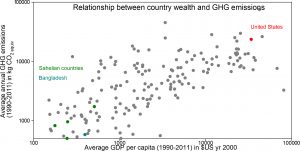
Note that there is a strong positive relationship between a country’s wealth and its greenhouse gas emissions. Since a country’s wealth is thought to reduce its sensitivity and increase its capacity to adapt to climate change, vulnerability to climate change is most likely highest among those countries who have contributed least to its cause (GHG emissions).
Also note the quite different positions of the United States (red dot) and the two areas that will serve as our case studies in this chapter: 1. Bangladesh in South Asia (cyan dot); and 2 Sahelian countries in West Africa including the countries of Senegal, Mali, Burkina Faso and Niger (green dots). These two case studies are examples of places in the world that have contributed very little to the problem of global warming while at the same time are extremely vulnerable due to sensitivity and limited capacity, but also due to high exposure. Both are locations that climate models predict will experience substantial but different impacts from climate change. As a low-lying coastal country, Bangladesh is exposed to sea level rise. The Sahelian region, lying just south of the Sahara desert, is exposed to increased variability of rainfall affecting the incidence of drought and flooding. Both offer examples of 1) the ways in which vulnerable populations may be affected, and 2) the adaptation measures that may be necessary for individuals, households and governments to adopt.
Make sure that you can find Bangladesh on the map of South Asia to the left and the West African Sahelian countries (Senegal, Mali, Burkina Faso and Niger) on the map of Africa to the right.
Considering vulnerability: Bangladesh
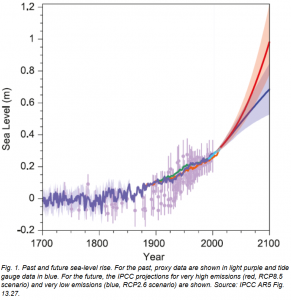 Sea level rise is expected to be a major effect of the warming of the earth’s climate due to the melting of land-based ice with the released water ending up in the oceans. Due to this phenomena, various estimates have been made about predicted sea level rise. For example in 2014, the Intergovernmental Panel on Climate Change, the international scientific body charged with synthesizing the available data on the effects of climate change, estimated global mean sea level rise under a range of scenarios, with a blue line, representing sea level rise if steep cuts in emissions were to occur and the red line representing sea level rise with continued high GHG emissions (see figure to the right).
Sea level rise is expected to be a major effect of the warming of the earth’s climate due to the melting of land-based ice with the released water ending up in the oceans. Due to this phenomena, various estimates have been made about predicted sea level rise. For example in 2014, the Intergovernmental Panel on Climate Change, the international scientific body charged with synthesizing the available data on the effects of climate change, estimated global mean sea level rise under a range of scenarios, with a blue line, representing sea level rise if steep cuts in emissions were to occur and the red line representing sea level rise with continued high GHG emissions (see figure to the right).
Subsequent estimates, that incorporate new understandings  of a more rapid breakup of the Antarctic ice sheet, with warming resulting in a more rapid sea level rise. Using these estimates, a study by the research organization Climate Central predicts the land that will be lost, and the associated number of people affected due to rising sea levels by 2100 based on the same IPCC scenarios described above. While this provides only a partial list of the countries affected, this and other studies point to South, Southeast and East Asia being particularly exposed to future sea-level rise.
of a more rapid breakup of the Antarctic ice sheet, with warming resulting in a more rapid sea level rise. Using these estimates, a study by the research organization Climate Central predicts the land that will be lost, and the associated number of people affected due to rising sea levels by 2100 based on the same IPCC scenarios described above. While this provides only a partial list of the countries affected, this and other studies point to South, Southeast and East Asia being particularly exposed to future sea-level rise.
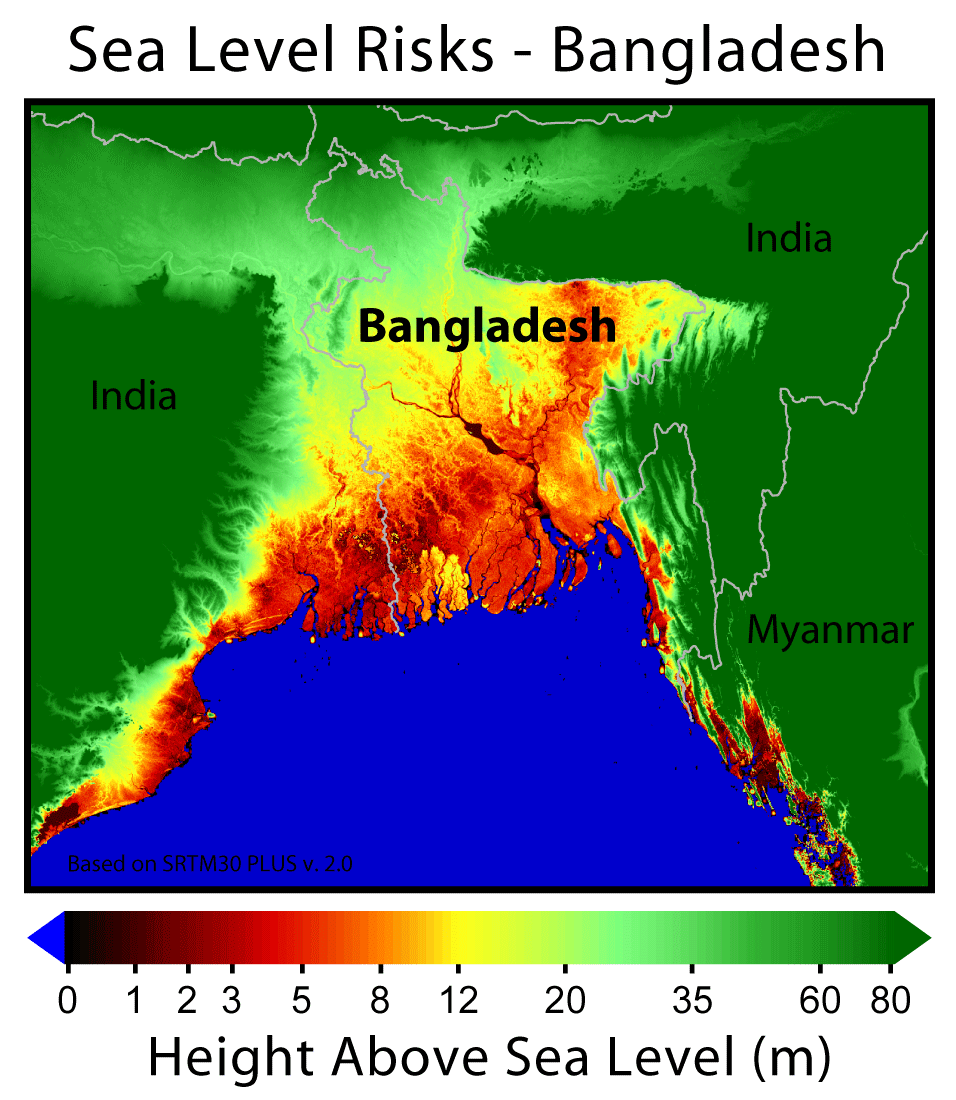
Bangladesh is one of the world’s most exposed countries to sea-level rise. This reflects the significant percentage of its land area that is within several meters of the current sea level. The added risks of sea level rise are not simply those caused by the gradual inundation of land as sea levels exceed the land’s elevation. Increased risks of salt water intrusion as well as the increased flooding and top soil erosion caused by more destructive storm surges at higher sea levels are probably more important. In addition, climate models suggest that changes in rainfall patterns tied to the monsoons will also increase the chance of flooding under climate change.
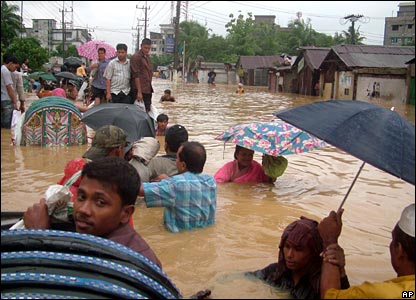
The effect of these exposures are magnified by the sensitivity of Bangladeshi society to them due to widespread poverty and to the fact that almost two-thirds of the population lives in rural areas (2016 statistics) and thus indirectly depends on agriculture. In this way, Bangladesh represents a range of developing countries vulnerable to sea-level rise, such as Vietnam, India, Thailand, China, and Myanmar as well as Island Nations such as the Maldives, the Philippines, and the Marshall Islands.
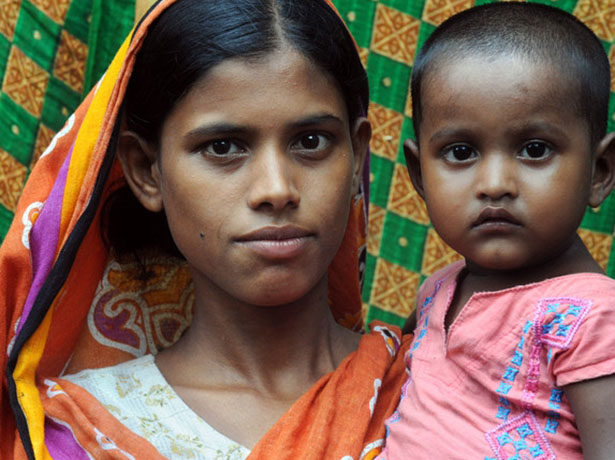
In evaluating how people are vulnerable though, it is very important to consider the social and economic systems that affect peoples’ lives. For example, in a country like Bangladesh, where women tend to have fewer resources to acquire income than do men, gender affects vulnerability. A female-headed household may be more vulnerable to flooding or sea level rise than a male-headed household simply because a woman will have a harder time finding income to repair the family’s house and to reestablish fields.
Watch the two videos on Bangladesh climate migrants below. As you watch, consider the following questions:
- People in the US who have resources to fall back on during hard times often have savings accounts in banks or retirement accounts. What kinds of resources do Bangladeshi villagers depend on? Why are those resources less transferable (than, say, a bank account) when they migrate?
- What kinds of resources are offered to Bangladeshis who have lost their homes in storms?
- Is there a difference between Bangladeshis and Americans when they lose their homes to weather events? How are their experiences different? Why?
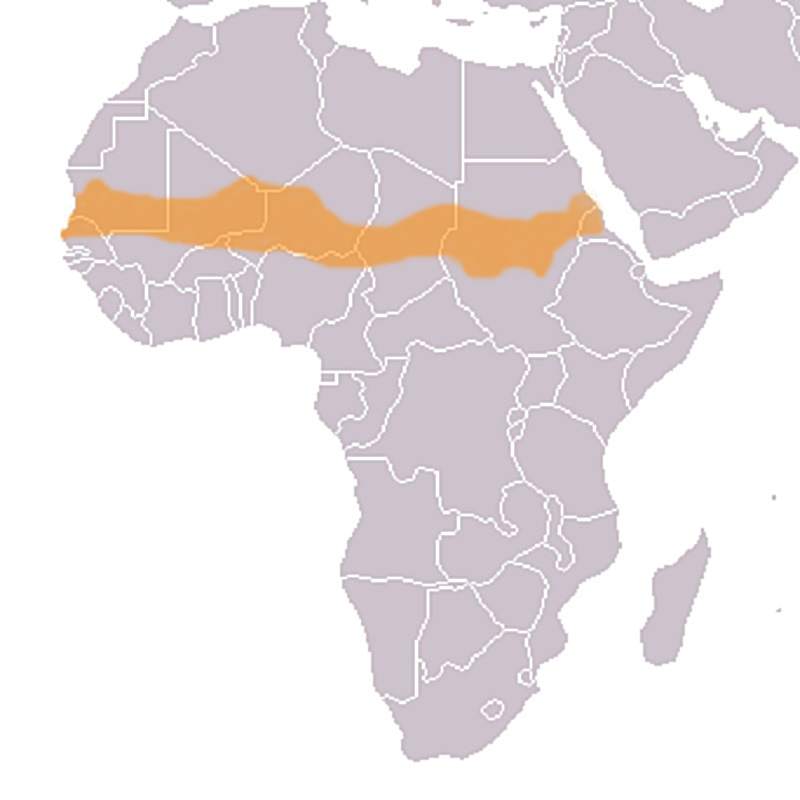
As Bangladesh, the Sahelian region lies in the tropics (+/- 23.5 degrees latitude) but it is farther from the equator and therefore drier. The word “Sahel” means “shore” in Arabic — the region which serves as sparsely-vegetated shore of the “sea” which is the Sahara Desert. It has long been an area of variable and sparse rainfall with native vegetation best described as steppe (brush land) changing, with increasing average rainfall, into savanna as one moves south from the desert edge. Rains always come during the rainy season, which is the northern hemisphere’s summer. Within that period though, rains are often highly variable.
Predicting changes in rainfall due to climate change is difficult anywhere and is especially difficult for the tropics. In general, climate change in the tropics is predicted to make dry areas farther from the equator drier and wet areas, closer to the equator, wetter. The Sahel, as a drier region, has been thought to become drier with climate change. The historical record of rainfall supports this. The figure below shows annual deviations of regional rainfall for the Sahel from its long-term average.
Rainfall in the Sahel: 1895 – 2005
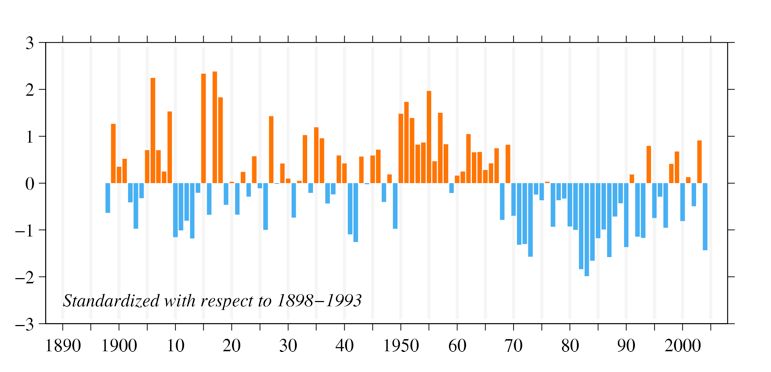
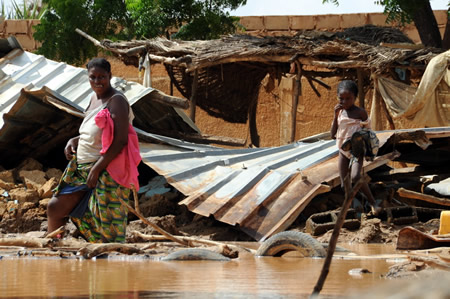
Since the early 1970s, there has been a significant drying trend with some recovery of rains since 2000. The rainfall “recovery” has been marked by changes in the distribution of rainfall within the rainy season, with more rain falling in large events separated by dry periods (associated with early cessation of the rainy season). This explains the flooding that has occurred during some recent years of harvest failure.
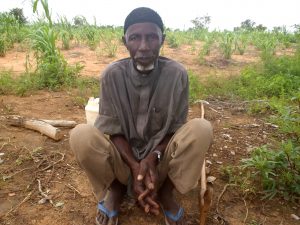
As in Bangladesh, the people of the Sahel are some of the world’s poorest, with large fractions of the population dependent on agriculture. The changes in the climate, with rains coming late or ending early, or even causing flash floods, affect how farmers grow their crops. Inadequate or poorly timed rains can mean farmers get no harvest. Sahelian farmers have been dealing with these kinds of conditions for a very long time, but conditions are becoming increasingly difficult. Grain (millet or sorghum) is the staple food for all families with local grain prices all rising rapidly during periods of shortage (drought years and near the end of the dry season when grain stocks become depleted). While different ethnic groups may specialize in particular livelihood activities, most rural families attempt to reduce the risk of food shortage and malnutrition through involvement multiple livelihood activities including crop agriculture (which provides major food staples), livestock husbandry (livestock is major store of wealth that can move to where rain occurs), and seasonal labor emigration to more resource-rich areas to the south (a source of cash). Small families and those lacking land and livestock are the most vulnerable. Women, due to their limited access to agricultural land, are often very vulnerable if their husbands have left to find work elsewhere. Thus, while there are significant differences in the risks facing Sahelian societies, the distribution of these risks show some similarities to the situation in Bangladesh.
